|
Last edited: 16 August 2017
|
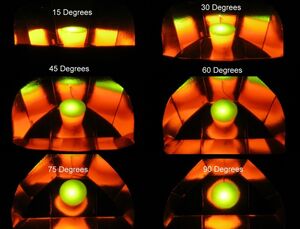
Reciprocal Photo Test for Measuring Solar Cooker Performance, (Earthbound Technology photo)
Various methods of testing are available to compare solar cookers. Not everyone in the solar cooking community, however, agrees on how to best test solar cooker variations, and how to report the results. Some argue for a standardized test with standard measurements calibrated to report absolute results. Others argue for a more low-tech, approach that measures only the relative difference between cookers or cooker variations when tested side-by-side.
There is also discussion about what to test and how to rate cookers. Is a cooker that cooks very fast, but has to be turned frequently to follow the sun better than a cooker that cooks slowly, but generally does not need to be reoriented to the sun? Many factors other than raw cooking power influence the appropriateness of one solar cooker over another.
Relative tests
A possible testing scenario:
- Heat a liter of water simultaneously in two cookers, one with the modification to be tested and one without. The two cookers to be tested could also be two completely different models.
- After a time (before the water boils in either cooker), measure the temperature of the water in both cookers.
- Use these measurements to determine how many degrees each cooker raised the temperature of the water.
- Calculate the percentage difference between these two temperature changes and report this along with a description of the modification that you tested.
Absolute tests
- "Stove performance varies greatly, and the performance of a specific stove is often different in the lab and in the field. Testing allows implementers to learn how well stoves perform and to quantify improvements in fuel efficiency and emissions. Test results can be used to guide implementation decisions and to improve stove design and performance. Below is a collection of stove testing resources that may be of interest to PCIA Partners." - PICA (More information...)
Water Boiling Test (WBT)
- The Water Boiling Test is a laboratory test that evaluates stove performance while completing a standard task (boiling and simmering water) in a controlled environment to investigate the heat transfer and combustion efficiency of the stove. They are the easiest, quickest, and cheapest to conduct, but reveal the technical performance of a stove, not necessarily what it can achieve in real households. WBT testing protocol
Controlled Cooking Test (CCT)
- The Controlled Cooking Test is a field test that measures stove performance in comparison to traditional cooking methods when a cook prepares a local meal. The CCT is designed to assess stove performance in a controlled setting using local fuels, pots, and practice. It reveals what is possible in households under ideal conditions but not necessarily what is actually achieved by households during daily use. CCT testing protocol
Kitchen Performance Test (KPT)
- The Kitchen Performance Test is a field test used to evaluate stove performance in real-world settings. It is designed to assess actual impacts on household fuel consumption and ease of use. KPTs are typically conducted in the course of an actual dissemination effort with real populations cooking normally, and give the best indication of real world changes. The KPT is benchmark testing that solar cookers will also need to be evaluated with. It will help in finding the appropriate solar cooking technology to partner with other clean-fuel cooking options. The primary goal is to find integrated cooking solutions to stem the environmental damage currently being caused by deforestation, and eliminating respiratory disease from cooking with smokey, inefficient fuels over open fires. KPT testing protocol
SCI Performance Evaluation Process (PEP)
In 2016, Solar Cookers International and the International Solar Energy Society began the process of creating an open-source solar cooker testing program called the Performance Evaluation Process (PEP) under the direction of Dr. Alan Bigelow. The project involves establishing a uniform method of testing, and then providing information for interested parties to build their own testing station. More information about the program can be seen at Performance Evaluation Process developments , and at Performance Evaluation Process.
News
- Thursday, 03. August 2017 (7pm EDT, 23:00 GMT/UTC): Solar cooker performance evaluation webinar - The International Solar Energy Society, ISES, joins with Solar Cookers International to provide the latest developments from the performance evaluation process (PEP) for solar cookers, to help provide consumers with useful information, and to hold manufacturers to a public accountability standard. Registration information...
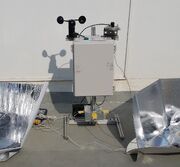
A Performance Evaluation Process (PEP) testing station
- June 2017: Solar Cookers International (SCI) launches pilot solar cooker testing centers in California and New York - The purpose of this pilot project is to check the repeatability, reliability and reproducibility of results from SCI Performance Evaluation Process (PEP) testing stations for solar cookers, irrespective of location. SCI’s pilot testing centers are located at different latitudes and at different elevations. The two locations also experience different weather conditions. The solar cookers, the cookware and the testing instrumentation, however, are the same at both locations. This pilot project is testing sets of three types of solar cookers: reflective-panel cookers, box ovens and parabolic reflectors. The PEP results provide cooking power measured in Watts, which is only one of many ways to evaluate solar cooker performance. In June, weather conditions at SCI’s pilot testing centers are well suited for testing solar cookers according to the ASABE S580.1 protocol for Testing and Reporting Solar Cooker Performance. This protocol requires that outdoor ambient temperature must be between 20 - 35 °C (68 - 95 °F). This temperature range is generally available at both SCI pilot testing centers between the vernal (spring) equinox and the autumnal (fall) equinox. Testing days within the required temperature range should also be clear days with consistent solar energy. SCI welcomes others to join this pilot solar cooker testing project to validate the reproducibility of the SCI PEP testing stations. By using the same instrumentation, results have a consistent format for data comparison. Potential project partners can access the assembly manual for the SCI PEP testing station, available as open-source content online at SCI’s PEP web page. To join SCI's pilot solar cookers testing project, email info@solarcookers.org
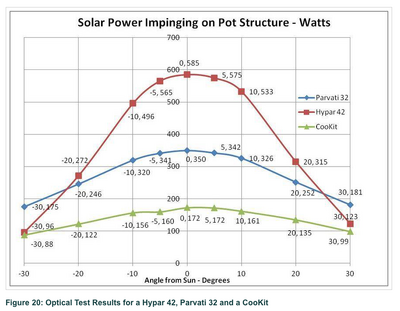
Credit: Earthbound Technology
- June 2017: Reciprocal optical testing - Earthbound Technology conducted their reciprocal optical testing on the Hypar Solar Cooker and Parvati Solar Cooker in April 2017, and used comparative data from a CooKit analysis done in 2014. The Hyper solar cooker reflector utilizes a combination of a conical outer ring with a parabolic inner dish. This allows for more diffuse solar energy directed at the cookpot, while still having some concentration that a parabolic reflector can provide. More information on reciprocal optical testing procedures and results can be found on their website at http://www.earthboundtech.com/optical-test.
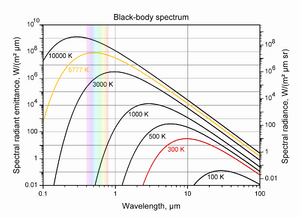
Transmission spectrum for Pyrex
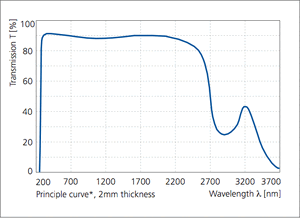
Transmission curve for Pyrex
- April 2017: Testing season begins for the Solar Cookers International PEP testing station - The SCI testing station for the performance evaluation process (PEP) for solar cookers was introduced during the 6th SCI World Conference 2017 held at the Muni Seva Ashram, Gujarat, India. Since then, the PEP testing station returned to the wintry weather of the SCI base in New York, where outdoor temperatures were too cold for testing according to the ASABE S580.1 protocol. With the arrival of spring and warmer temperatures, the PEP testing station is now primed for a testing season. Meanwhile, the SCI PEP team has 1) built a second PEP testing station for its base in California; 2) established a 2-point calibration routine for thermocouple measurements; 3) is finalizing an assembly manual for its testing station, geared for open-source use; and 4) will soon launch a pilot project to validate the SCI PEP at several locations worldwide. In a preliminary experiment, the SCI PEP testing station measured significant improvement in the CooKit solar cooker performance when the plastic bag glazing was replaced with a clamshell of two 4-quart Pyrex bowls. The transmission spectrum for Pyrex shows that it has high transmission for visible light (it lets sunlight in) and poor transmission for infrared light emitted from a hot black-body irradiator (it blocks heat radiation from a cooking pot from escaping).
- January 2017:
- August 2016: Solar cooker performance evaluation process - Dr. Alan Bigelow and will be presenting the Solar Cookers International solar cooker performance evaluation process (PEP) at the 6th SCI World Conference 2017 in Gujarat, India in January 2017.
- July 2015: ASABE makes ASAE S580.1 NOV2013 available online for free - Paul Funk reports that ANSI member, The American Society of Agricultural and Biological Engineers, has officially made Standard ASAE S580.1: Testing and Reporting Solar Cooker Performance available online for free for humanitarian reasons.
- April 2014: Bernhard Müller describes his latest approach for measuring the aperture openings, or solar collection area, for solar cookers here: Explanations of the Aperture Area - Bernhard Müller

Reciprocal Photo Test for Measuring Solar Cooker Performance, (Photo: Earthbound Technology)
- April 2014: A photo is used to evaluate solar cooker output William Bradley, founder of Earthbound Technology, has been working on developing a new approach for analyzing the potential performance output for solar panel cooker and parabolic solar cookers. It involves placing a light source into the cookpot and photographing and measuring the reflected light. Read a summary at: Reciprocal Photo Test for Measuring Solar Cooker Performance
- March 2014: The global solar cooking sector acquires a delegate to participate in establishing cookstove and clean cooking solutions standards - Paul Funk from the USDA Agricultural Research Service, and former Solar Cookers International Board member, with a strong background in solar thermal cookstove testing, has been approved as a delegate by the International Organization of Standardization(ISO) community. Paul was a delegate to the plenary ISO Technical Committee 285 meeting held in Nairobi, Kenya February 10-14, 2014. He joined wood stove experts from 11 countries and 4 liaison groups (The Global Alliance for Clean Cookstoves, The World LP Gas Association, The World Bank, and UNICEF) for a week of technical meetings to develop standards for testing clean cookstoves. Dr. Funk earned a Ph.D. analyzing solar cookers, and later wrote a test standard for solar cookers (ASAE S-581). He taught mechanical engineering and now is a scientist with the USDA Agricultural Research Service. He states “My goals must be modest. As a delegate representing the USA, I must support the consensus position of the American National Standards Institute, and not my own opinions. I hope, however, to exert some small influence to prevent solar cookers being excluded or rated poorly by the clean cookstove test standard.”
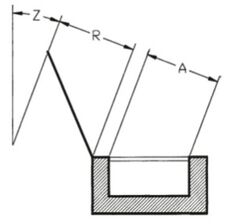
Determining the solar intercept area, ASABE S580.1
- December 2013: Technical testing standards for solar cookers updated - The American Society of Agricultural and Biological Engineers (ASABE), based in St. Joseph, Michigan, USA, has revised its solar cooker standard. The organization is recognized worldwide for developing voluntary standards for food, agricultural, and biological systems. Often sited in technical reviews, the updated version will replace the current standards established ten years ago. The goal is to promote uniformity and consistency in the terms and units used to describe, test, rate, and evaluate solar cookers, solar cooker components, and solar cooker operation. However, it is outside of the scope of the standards to factor in cost, durability, and user satisfaction. Review the new standards: ASAE information on Testing and Reporting Solar Cooker Performance
- November 2012: ASABE (the society for engineering applicable to agricultural, food, and biological systems) is revising the international standard, S580, "Testing and Reporting Solar Cooker Performance." The intent of this standard is to make it possible to test solar cookers with a minimum investment in technology, in any location, while arriving at a value that is repeatable independent of climate, and easily understood. It uses Watts of cooking power to rate box-type, panel-type and concentrating (or parabolic dish-type) solar cookers. The document may be viewed here: http://solarcooking.org/asae_test_std.pdf and comments may be sent to: pfunk@nmsu.edu.
- February 2012: Ajay Chandak, a respected and experienced innovator with solar cooking technologies, has provided the following insights to stove testing. It appears one of his greatest concerns is that all stoves, solar and bio-fuel types, be tested with the same procedures and using the same criteria. This will provide relevant information to be able to compare all the various cooking technologies. His comments are below:
- I think we need all three tests. During recent training program at our end we included WBT and CCT for solar cookers. My view is that all three tests are required for any cook stove for following reasons.
- 1. WBT: This test is useful for rating cookstoves in one category: For e.g. if we talk of solar dish cookers then this test compare different dish cookers on their performance, efficiency etc. Same is valid for other cookstoves. We can compare all woodstoves on one to one basis. I think the test needs to be simplified from the current form.
- 2. CCT: This test provides fuel saving potential of the cookstove with presumption that both the existing cooking option and proposed new cookstoves are operated in the best possible manner. All cookstoves, irrespective of fuel type, renewable or fossil, solar, biogas, biomass, LPG, kerosene will be compared with what so ever the cookstoves we want to replace. So this test provides comparison amongst different technologies while WBT provides comparison amongst same technology. CCT is utmost important to get solar also introduced as one of the possible options, and it can only be accepted by different committees and bodies if we provide them comparative scale of solar with other technologies. CCT will also form the benchmark for any carbon funding activity for renewable energy project to know what is the carbon emission saving potential of a particular technology.
- 3. KPT: This is practical version of CCT. In CCT we presume that the existing cooking technology and new proposed technology are used in best possible manner. However in practice it is not so. Moreover in CCT fuel/emission saving potential will depend on time of usage by the end user, which we take by estimate. In KPT we are replicating real life situation to find out actual saving potential considering all uncertainties in usage timing, variation in food habits, variation in cooking quantities, variation in cooking practices etc.
- I think we need all three tests. During recent training program at our end we included WBT and CCT for solar cookers. My view is that all three tests are required for any cook stove for following reasons.
- For this reason we need to consider same set of tests for all technologies. There may be additional tests for few technologies, but at least WBT, CCT and KPT should be common to all. Any way WBT and CCT also hardly require any costly equipment, normally a thermometer and weighing machine is adequate for these tests. I feel that all tests should be as simple as possible and sample sizes to be reduced to less than 3% in case of KPT. As CCT establishes the benchmark on how much can be saved, it makes sense to reduce the sample size in KPT.
What to test
A focus only on speed and highest temperatures eliminates one important feature for some. The intuitive "fastest, hottest is always best" overlooks the benefits of slow, unattended cooking where food never burns and sun angle adjustments are seldom needed. This is often mentioned as a favorite feature by consumer feedback from women around the world. A bias against slow, gentle solar cookers that cook like crock pots - ideal for many favored dishes - reduces market access for large populations of women whose daily needs and finances often don't fit with using the "hottest, fastest" devices.
Solar cooker designers' reliance on what they THINK is best for women is too seldom confirmed by consumer feedback, which varies widely with region-specific foods, women's daily demands, climate, etc.
Audio and video
- August 2017:
Webinar - Solar cooker performance evaluation
This webinar was organized by the International Solar Energy Society with assistance of Solar Cookers International. Agenda • Julie Greene (Executive Director, Solar Cookers International) - Overview of solar cooking and responding to the need for solar cooker evaluations • Dr. Paul Funk (Member, American Society of Agricultural and Biological Engineers) - The ASAE S580.1 protocol for Testing and Reporting Solar Cooker Performance • Dr. Alan Bigelow (Science Director, Solar Cookers International) - Implementing the SCI Performance Evaluation Process (PEP) • Anne Patterson (Founder and CEO, Solavore) - The value of solar cooker PEP results: a manufacturer's perspective speakers biographies and more details here: https://www.ises.org/what-we-do/events/webinar/solar-cooker-performance-evaluation
- January 2017:
- September 2015:
|
- July 2015:
- July 2014:
- July 2014:
- July 2014:
- July 2014:
- July 2014:
- July 2014:
Documents
- April 2014: The Water Boiling Test for Solar Cookers – WBT SC - Bernie Müller & Faustine Odaba
- December 2013: ASAE information on Testing and Reporting Solar Cooker Performance
- August 2013:ASAE Standard S-580.1 - Testing and Reporting Solar Cooker Performance (revised version) - Paul Funk
- 2009: Proposal for New World Standard For Testing Solar Cookers (2009) - Ashok Kundapur
- July 2006: Proposal for New World Standard for Testing Solar Cookers - Ashok Kundapur
- January 2003: ASAE solar cooker performance testing standards
- August 1999: Evaluating the International Standard Procedure for Testing Solar Cookers and Reporting Performance - Paul Funk
- January 1990: Comparative Study of Box-Type Solar Cookers in Nicaragua — Daniel Kammen and William F. Lankford. Published in Solar & Wind Technology
- December 1977: Solar Cookers for Haiti - Bowman, Sharber, Blatt
- Thesis on Solar Cooking Testing Standards - Shawn Shaw
See also
- Reciprocal Photo Test for Measuring Solar Cooker Performance
- Paul Funk
- Florida Solar Energy Center
- Parabolic solar cooker standards
- Thermometers
- Calculating efficiency
External links
- Information on the ISO-TC-285 Cookstoves Standards
- Solar Cooker Development and Testing Program - Florida Solar Energy Center
- PICA Stove Performance Testing Protocols
- International Standards for Testing Solar Cookers - Dr. Paul Funk
- Instrumentation error analysis of a box-type solar cooker - Ishan Purohita and Pallav Purohit










